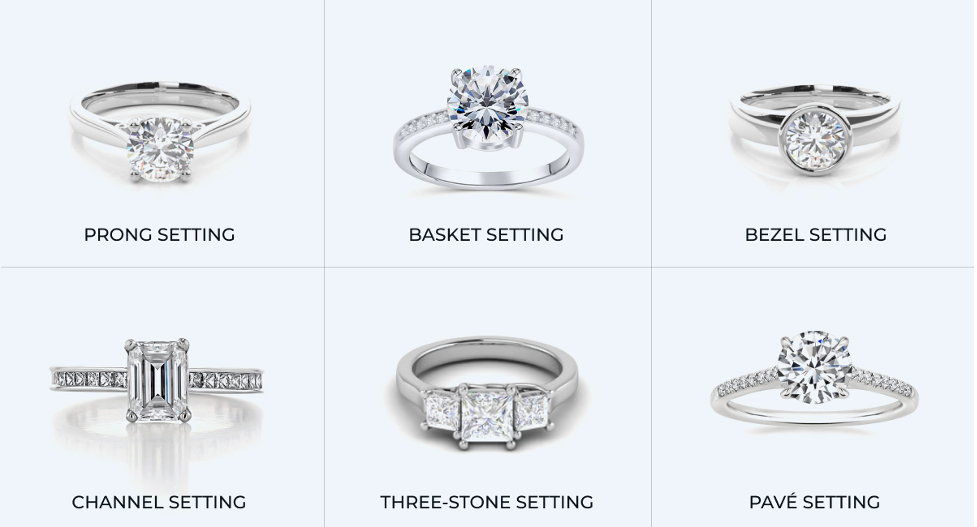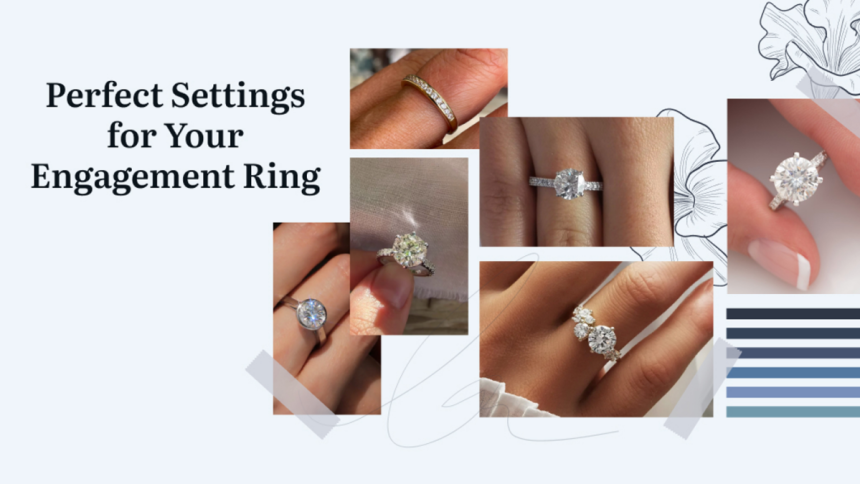You need a perfect engagement ring to bring the design together and improve the beauty of the stone. From timeless classics to contemporary designs, engagement ring settings secure the gemstones and express the wearer’s unique style. Suppose you’re wondering how to choose the ideal setting for your engagement ring. This blog will guide you through some of the most popular options, important factors to consider, and how to customize your design for a truly personal touch.
Types of Ring Settings:
Engagement Ring Settings are in various designs, offering unique aesthetics and functionality. Below, we explore some of the most popular types:
Prong Setting-
The prong settingis a classic and widely preferred choice for engagement rings. It uses small metal claws, typically four or six, to hold the center stone securely in place. This design allows maximum light exposure, enhancing the diamond’s brilliance.
Bezel Setting-
The Bezel Setting is known for its modern, sleek design and exceptional durability. This style encircles the diamond with a thin metal rim, providing maximum protection from damage and wear.

Basket Setting-
A basket setting engagement ring offers a slight variation of the prong design by adding horizontal metal bands that form a “basket” around the stone. This additional structure provides more security and durability while allowing the diamond to sit lower on the finger.
Channel Setting-
The channel setting is characterized by a row of smaller stones set closely together between two parallel metal bands. This style is often used for wedding bands or as an accent to the main stone. Its smooth surface provides a polished look and is less likely to snag on clothing, making it an excellent option for everyday wear.
Three-Stone Setting-
A three stone engagement ring features a central diamond flanked by two smaller stones. This design symbolizes a couple’s past, present, and future, making it a romantic choice. The additional stones can be diamonds or other gemstones, offering versatility in style and color.
Pavé Setting-
The pavé engagement ringsetting is all about maximizing sparkle. It features a band encrusted with tiny diamonds set closely together, creating a “paved” effect. This design adds a layer of brilliance without overshadowing the center stone.
Cluster Setting-
In a cluster setting, smaller diamonds or gemstones are arranged to create the illusion of a larger stone. This design is a perfect choice for those who want an eye-catching ring on a smaller budget.
What Factors Are Consider When Choosing Setting?
When you are looking for a setting, you need to keep the following factors in mind –
Understanding Lifestyle-
Your lifestyle plays a huge role in determining the best setting. For those with active lifestyles or jobs that involve frequent hand use, settings like bezel or basket offer enhanced durability and protection. Conversely, high-profile settings like prong or cathedral are better suited for occasional wear.
Personal Style-
Your engagement ring should reflect your personality. If you prefer a classic look, go for solitaire or prong settings. Vintage lovers might opt for halo or pavé designs, while those with a modern taste can choose bezel or tension settings.
Stone Shape-
Certain settings pair better with specific stone shapes. For example, abezel setting complements round and oval diamonds, while prong settings are versatile enough for almost any shape, including princess, marquise, or pear. Choosing the right combination enhances the diamond’s natural beauty.
Metal Type-
The metal type influences the overall aesthetic and durability of your ring. White gold and platinum are popular for modern and sleek designs, while yellow and rose gold add warmth and a vintage feel. Ensure the metal complements the diamond’s color grade for a cohesive look.
Budget-
Understanding how much an engagement ring should cost is crucial. While solitaire settings are budget-friendly due to their simplicity, designs like halo or three-stone settings may increase prices because of additional stones and intricate craftsmanship.
Can You Customize Your Ring Setting?
Customizing your engagement ring setting allows you to create a one-of-a-kind piece that reflects your personality and preferences. You can choose the metal type, such as platinum or rose gold, to match your style. Adding engravings, like initials or a special date, can make the ring more meaningful. Adjusting the design—such as modifying the prong style, selecting unique side stones, or incorporating a hidden halo—ensures the final piece is tailored to your vision.
What are the Common Mistakes to Avoid When Choosing a Ring Setting?
Several common mistakes can lead to dissatisfaction or frequent maintenance issues when choosing a ring setting. One major misstep is overlooking practicality—opting for a setting that doesn’t align with your lifestyle.
For instance, high-profile designs like prongs or cathedral settings are prone to snagging, which makes them less ideal for individuals with active lifestyles. Another common pitfall is neglecting maintenance requirements. Settings such as pavé or cluster designs may look stunning but often demand regular maintenance to avoid issues like stone loss or wear.
Conclusion:
Selecting the perfect engagement ring setting is all about finding the right balance between beauty, functionality, and individuality. By familiarizing yourself with the different types of settings, factoring in your lifestyle and personal preferences, and steering clear of common pitfalls, you can confidently choose a design that beautifully reflects your love story.
FAQs:
What Setting is Best for an Engagement Ring?
The best setting depends on your lifestyle and preferences. Prong settings are timeless and elegant, while bezel settings offer durability and a modern look.
How Much Should an Engagement Ring Cost?
Engagement ring costs vary based on factors like diamond size and setting complexity. Allocate 2-3 months’ salary as a traditional guide, but spend what feels comfortable.
How do I Know Which Setting will Suit My Personal Style?
Consider your overall aesthetic. Classic styles suit solitaire settings, while modern tastes lean toward bezel or tension designs. Vintage enthusiasts may prefer halo or pavé settings.
What is the Most Secure Setting for a Diamond?
Bezel settingsare the most secure because they encase the diamond in a protective metal rim, reducing the risk of damage.
What Type of Setting Makes a Diamond Look Bigger?
Halo settings create the illusion of a larger diamond by surrounding the center stone with smaller accent stones.
What Setting Makes a Diamond Sparkle Most?
Prong settingsmaximize light exposure, enhancing the diamond’s brilliance and sparkle.
Lynn Martelli is an editor at Readability. She received her MFA in Creative Writing from Antioch University and has worked as an editor for over 10 years. Lynn has edited a wide variety of books, including fiction, non-fiction, memoirs, and more. In her free time, Lynn enjoys reading, writing, and spending time with her family and friends.















